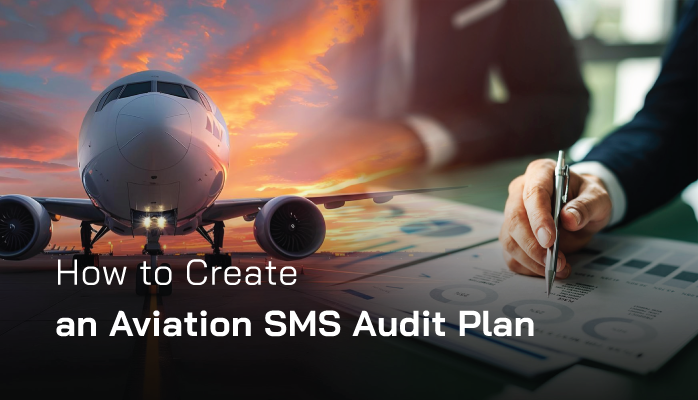What Is an Internal Aviation SMS Audit

An internal aviation safety management system (SMS) audit is a process you use to verify that certain actions are taking place in your SMS.
Audits are a safety assurance activity that is most commonly used to broadly assess whether or not aviation service providers can demonstrate continuous improvement of the SMS.
That being said, you might have different auditing processes for assessing different aspects of your SMS, such as:
Related Articles on Aviation SMS Audits
- Real Difference Between an Aviation Safety Audit vs. Inspection
- How to Conduct Internal SMS Audits in Aviation Industry
- 5 Ways to Prepare for Aviation SMS Audits
Internal aviation SMS audits are generally used to prepare for external audits by compliance authorities. They help you identify deficiencies in your SMS and correct them before auditors “ding” your safety program with a finding.
Creating an aviation SMS audit plan for each auditing process is absolutely crucial for performing good audits.
What Is an Internal Audit Plan
SMS internal audit plans are your roadmap for performing your audits. They are your auditing processes that outline:
- The type of auditing process, such as
- Safety Policy audit,
- SRM audit, or
- Continuous improvement audit
- Which auditing forms are used to conduct the audit;
- Which departments/divisions are included in the audit;
- Which parts of the aviation SMS will be audited;
- The frequency that audits will occur;
- Who will be conducting the audit; and
- The steps that will be used to conduct the audit.
An auditing plan should be laid out in very clear terms. You should be able to show your auditing plan to a stranger and provide them with all of the information they need to understand the scope of each type of audit.
Purpose of Internal SMS Audit Plan
The purpose of internal SMS audit plans is to create a road map for your audits. They are a way to control the way you conduct audits. If you are not happy with your auditing results, you can easily change the way you audit by changing your auditing plan.
Without auditing plans, you:
- Have to depend on people rather than the system for performing audits;
- Risk having unreliable audit process;
- Risk having incomplete audits; and
- Risk inconsistent audit results.
Audit plans ensure that your audits are:
- Consistent;
- Complete; and
- Follow your designed processes.
Furthermore, an auditing plan allows you to involve independent third parties to perform your internal audits in a way that you can manage expectations. There are many private auditing companies that you should be wary of, especially the ones that lack objectivity and a sound "moral compass."
Additional Articles on Aviation SMS Auditing
- Aviation Safety Audit Preparation - 4 Free SMS Audit Checklist Templates
- How IATA Operational Safety Audits Enhance Aviation Safety Process - With Free Checklists
- What Are Static & Dynamic Components of Aviation Safety Auditing?
Creating Auditing Form

Each auditing plan should have its own auditing form. This auditing form will outline the steps for completing the audit. Each question will involve a different action on the part of the auditor for assessing your SMS.
For example, your Safety Policy audit will have a separate auditing form from your continuous improvement audit. Good auditing forms:
- Have many questions to evaluate a particular aspect of your SMS;
- Have consistent answer types, such as True/False;
- Are organized by type of questions, area of operations, or whatever other scheme makes sense; and
- Should necessitate actually doing some field work to get information, as to involve employees in the auditing process.
Each question should also indicate whether there is a finding and include space for additional comments by your auditing team.
Plan Who You Will Audit
Each of your auditing plans should indicate explicitly who it will be auditing. In this case, “who” means the following should be documented as far as who is being audited:
- Which roles;
- Which departments;
- Which locations; and
- Perhaps which individuals.
There may be other “who” aspects of your company that you need to document, depending on your operations.
Plan What Parts of SMS You Will Audit
You need to lay out in explicit detail which parts of your SMS you will be auditing. For example, if you are auditing continuous improvement, you will want to document that you are:
- Sampling risk assessments from past issues;
- Key performance indicators;
- Vendors interface;
- And so on.
If you are auditing safety policy, you would want to indicate in your audit plan that you are auditing:
- Safety policies/procedures;
- Roles and responsibilities;
- Safety objectives and goals;
- And so on.
Your auditing form and this part of your auditing plan should be in perfect alignment: there should be no audit form questions that do not match up with “what” you will be auditing in your audit plan.
Additional Articles on Auditing in Aviation SMS
- Audit Checklist: 10 Things to Prepare for Aviation SMS Audits
- Aviation Safety Audits 101: Prep and Pass [Free Audit Checklists]
- How to Think Like an Aviation SMS Auditor
Plan How Often to Conduct SMS Audit
The last piece of important information your audit plan should include is how often you will be conducting the audit. We recommend that any given type of internal SMS audit be conducted at least once per year, or before an external audit if it comes sooner.
You might indicate:
- The month(s) that the audit is to be performed; or
- The circumstances that initiate an audit.
Last updated May 2025.






